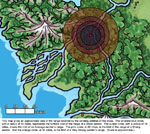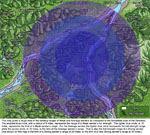Sending
Overview
Sending (i.e. telepathic communication) is a type of magic that is universally found amongst the wolfriders. Every member of the tribe is able to both send and receive sends. The ability is, generally, universal amongst elves. (It is possible for elves to "forget" about it through disuse. Those elves will still possess the ability to send, but would have to re-learn how to do it.) While the ability to send is innate, therefore, it must be practiced and learned to achieve proficiency in it.
In the later stages of pregnancy, a mother becomes able to send to and receive feedback from her unborn child, including the child's soul-name. Children do have to learn sending in the same way that they learn to talk. Children are able to receive the sending of parents and other adults from the beginning, but it is not always clear that they understand the contents of sending (except for basic emotions) until about the same time they begin to exhibit understanding of spoken words -- children may begin to heed a parent's sending as early as 12 months, but on average around 18 months to 2 years. Children themselves will begin to send around the same time, but the content of their sending tends to mirror that of their command of spoken language. A child's sending tends to be simplistic and emotion-laden. Because children have to learn control of sending, they are prone to "spilling" their emotions in uncontrolled sendings, and may disturb the entire tribe by sending vividly during dreams. This tendency may last through childhood and only end with the onset of puberty (it will cease altogether once the child learns his/her soul-name).
While there are no elves who cannot send, sending strength varies between individuals. Just as some elves can run faster than others, and some have better hearing or eyesight than others, some are stronger or weaker senders than others. The upper range of sending strength turns into the "going out via the spirit-world" powers of Savah, Suntop, and Winnowill in canon -- but that skill is typically not found amongst wolfblooded elves, and no one in the River Twine tribe is that strong. Sending does require effort, and a weakened physical condition can affect an elf's ability to send over distance. (However -- see above -- if a sender uses an elf's soul-name, even if the elf is in a weakened condition or unconscious, they will get at least a responsive echo signifying that the elf lives.)
It should be kept in mind that sending is not merely "talking without words/sound". Elves are able to convey images and emotions as well; some sends may be on this simpler, direct level and not contain words at all.
The elves have a maxim that says "there is only truth in sending". This is a factual truth -- while an elf might attempt to send a falsehood, the recipient would basically detect that intention along with the rest of the send's contents, and know the difference between truth and lie. (So, while it is possible to try to send a lie, it isn't possible to fool the recipient.) However, the contents of a send are dependent on an elf's subjective point of view. Elves need to be aware that there may be "viewpoint bias" in another elf's sending -- they may faithfully be communicating what they have seen (or think they have seen) and understand, but there may be a gap between that perception and reality.
SENDING DISTANCES
While sending is a magical power that is universal to all elves, there are limits to it. Overall, sending has a limited range. The exact limits vary according to individuals: elves are broken up into four categories, Weak, Average, Strong, Very Strong; (more on this below; a fifth category, Exceptional, would apply to super-senders from canon such as Suntop, Savah, etc.; notably, all of these Exceptional senders are pureblooded elves. There is no possibility that anyone in the RTH tribe will be of this power level).
Each individual also has a "full strength" range and a "limited" range, with a hard cap on the latter. Sends within the full-strength range are assured to be successful, with no straining to "hear" the other person and no chance of losing information. Sends up to the limit of the range will still go through, but the elf will perceive the send to be "faint" ("a whisper", for example), and there may be a danger of some information being garbled or lost.
Sending cannot be impeded or reduced by anything but distance. It is not interfered with by physical barriers (such as a mountain range, or being inside a cave), or by atmospheric conditions (it isn't harder to make contact or "hear" within a storm).
However, elves can "ignore" a send, i.e. not answer. They have to make a conscious decision not to connect with the sender, though. The sender will still receive a "ping" that tells them that they did reach the other and that the receiver blocked (i.e. the sender will not mistake a refusal-to-connect for out-of-range, unconsciousness, or death). Unconsciousness also interferes with sending, but the sender who tries to connect to an unconscious elf will still receive a "ping" that tells them that the other elf was in range, and that they are alive. (This meshes with the expression in canon that the only thing that can silence a reply is death, though it seems to be understood that this is true only within range.)
Some past discussion of this topic can be found on the RTH messageboard (you must be a member to access this) here: http://rth.ellenmilliongraphics.com/viewtopic.php?f=3&t=2189
If you have any questions about how this works, especially for plotting a story, please contact the Council, or post a question in a new thread in the Dentrees area of the messageboard.
THE "ALERT PULSE"
In order to account for the way sending seems to behave, we have come up with this explanation – that a component of sending is an automatic (reflexive, not conscious) sending out of an "alert pulse" from the sender to the receiver. Think of it this way:
Elf A initiates a send to Elf B. Accompanying/underlying that send is the alert-pulse ("you have a call"). The alert-pulse hits Elf B, which is what causes B's sending ability to "turn on" and "reach back" to Elf A, receiving the call.
The alert-pulse really consists of almost no information; it is just a trigger for the receiver to "pick up" and add their magic to the act of receiving. Plot-use-wise, though, if for some reason Elf A sent an alert-pulse, that Elf B receives, and yet Elf B "turns on" and doesn't effectively receive anything from Elf A (for whatever reason – they were in motion and moved out of range; they went unconscious; they "failed the d20 roll for contact at greatest distance"; etc.), Elf B would still know, "hey, Elf A just tried to send to me, and I didn't get anything!" Also, as described above, the "ping" itself can convey information -- that Elf B is in range; whether or not they are unconscious; if they are blocking a reply; or, if they are dead.
Part of the reason for incorporating this concept into the system is to smooth over variations in elf sending ranges. This is a "reach back" idea that allows for each elf's range to add up into a combined range, and "meet in the middle". It also allows for a stronger sender to contribute that strength to the receiving process.
So in the above example: say that Elf A, the sender, is average (and their send can only reach 15 miles at its greatest limit), but Elf B is Very Strong, so their greatest range is 30 miles. Elf A's alert-pulse can effectively travel FARTHER than Elf A can send – in this case, it can travel far enough to "ping" Elf B and get them to "reach back" to receive. Thus, sending contact between the two can be made so long as the weaker sender is within a distance of the combined ranges of both (in this case, 45 miles).
(Elf B's contribution would then "boost the signal", allowing him to receive Elf A's send; but because it is at the greatest range for both of them, it is more likely that both elves will experience the sending contact as "a whisper", or for Elf B to receive partial or garbled information from A's send.)
SENDING RANGES

Full Size

Full Size
Weak – 6 miles full-strength; 10 miles greatest limit
Average – 10 miles full-strength; 15 miles greatest limit
Strong – 12 miles full-strength; 20 miles greatest limit
Very Strong – 15 miles full-strength; 30 miles greatest limit
In kilometers:
Weak – 9.6 km full-strength; 16 km greatest limit
Average – 16 km full-strength; 24 km greatest limit
Strong – 19 km full-strength; 32 km greatest limit
Very Strong – 24 km full-strength; 48 km greatest limit
CURRENT TRIBE
Weak – Newt, Otter, Quick Fang, Windsong
Average – Beetle, Brightwood, Chicory, Cloudfern, Crackle, Dreamflight, Evervale, Fletcher, Foxtail, Goldspice, Greenweave, Honey, Kestrel, Moss, Nightstorm, Notch, Pathmark, Rainpace, Starskimmer, Thornbow, True Edge, Whispersilk, Willow,
Strong – Blacksnake, Fadestar, Longshot, One-Leg, Snowfall, Suddendusk,
Very Strong – Farscout, Windburn